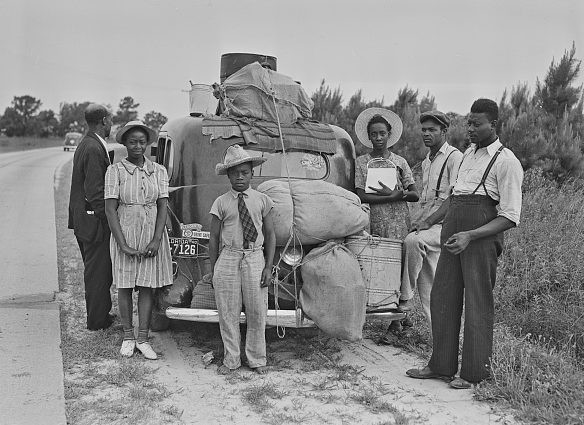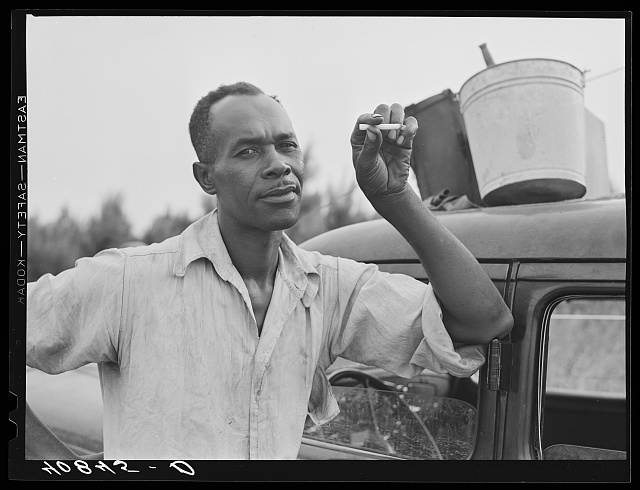
Freight cars waiting to be loaded with potatoes, Camden, N.C., 1940. Photo by Jack Delano. Courtesy, Library of Congress
I discovered another forgotten chapter in eastern North Carolina’s history while I was exploring the Farm Security Administration (FSA)’s photographs at the Library of Congress— it is a story about the migrant farm workers that harvested the region’s crops in the 1930s and ’40s.

Near Shawboro, N.C., 1940. Having finished the potato harvest, this group of Florida laborers was bound for New Jersey. Photo by Jack Delano. Courtesy, Library of Congress
An FSA photographer named Jack Delano took the photographs that caught my eye. He’s the same photographer that took the photographs of the migrant construction workers at Fort Bragg that I discussed here last week.

Farm workers eating supper on the front porch of the company store in Belcross, N.C., 1940. Photo by Jack Delano. Courtesy, Library of Congress
A talented photographer and composer, Delano was a Ukrainian Jewish immigrant who had come to the U.S. with his family in 1923, when he was nine years old. All of his photographs show a warmth and sympathy for others and a special concern for the down and out.

A farm worker from Texas at the potato grading station in Belcross, N.C. He was making 20 cents at hour. According to Jack Delano, the man dreamed of having his own sweet potato farm one day. Courtesy, Library of Congress
He was one of an extraordinary group of photographers that worked for the FSA during the Great Depression and the Second World War. They included figures such as Dorothy Lange, Gordon Parks and Marion Post Walcott that are now icons in the history of documentary photography.

Waiting for the foreman to show up, Belcross, N.C., 1940. Delano indicated that they were being paid a dollar a day. Photo by Jack Delano. Courtesy, Library of Congress
Delano took the photographs of migrant construction workers at Fort Bragg in March of 1941. But nine months earlier, when the FSA was still focused on the economic turmoil of the Great Depression, he had spent time with other migrant workers in a different part of eastern North Carolina.

A young migrant laborer picking potatoes at T. C. Sawyer’s farm in Belcross, N.C., 1940. Photo by Jack Delano. Courtesy, Library of Congress

Migrant farm worker near Belcross, N.C., 1940. Delano did not mention her name or anything about her, only that she was from Florida. Photo by Jack Delano. Courtesy, Library of Congress
In the summer of 1940, he took a remarkable series of photographs of the migrant laborers that harvested and packed potatoes in a group of counties not far from the Outer Banks.

Sacks of potatoes at freight station, Camden, N.C., 1940. Photo by Jack Delano. Courtesy, Library of Congress
Traveling up and down the East Coast, those men, women and children worked in orchards and fields from Florida to New Jersey.

Outdoor kitchen for a labor camp in Old Trap, N.C. Approx. 35 men and women stayed at the camp during the potato harvest. Photo by Jack Delano. Courtesy, Library of Congress
In the wintertime, most worked in the citrus groves and vegetable fields of South Florida. They lived in sprawling camps of laborers in places such as Belle Meade, Immokalee and Homestead.

Migrant farm laborer in Belcross, N.C., 1940. She may be in her traveling clothes or headed to church; Delano did note that it was a Sunday. Photo by Jack Delano. Courtesy, Library of Congress
When they finished the harvest in Florida, they worked their way up the East Coast. The farm laborers in Delano’s photographs harvested potatoes here in North Carolina in June and July, then headed to jobs further north. Delano reported that they traveled next to Onley, a village on the Eastern Shore of Virginia, and to Cranbury, a small town in southern New Jersey.

Night shift at the potato grading station in Camden, N.C., 1940. Photo by Jack Delano. Courtesy, Library of Congress
That summer of 1940 Delano photographed migrant potato workers in Shawboro in Currituck County, N.C., and in the small town of Camden and in the rural farming communities of Belcross, Shiloh, Camden, and Old Trap in Camden County, N.C.

Migrant laborers from Florida in their tent next to the grading station in Belcross, N.C., 1940. Photo by Jack Delano. Courtesy, Library of Congress
He also photographed migrant laborers grading and packing potatoes in Elizabeth City, in Pasquotank County, N.C. That town of roughly 11,000 people had the closest freight depot to those other communities.

Belcross, N.C., 1940. Some of the farm workers stayed in old farmhouses, some in tents, some in boardinghouses in Elizabeth City’s African American neighborhoods. Others just slept in the potato warehouse. Photo by Jack Delano. Courtesy, Library of Congress
By 1940 migrant laborers had harvested crops in that area and in many other parts of eastern North Carolina for decades. Some had originally come from other parts of eastern North Carolina. Some came from other southern states.

Kitchen at a labor camp in Belcross, N.C., 1940. Photo by Jack Delano. Courtesy, Library of Congress
Many had also come to the U. S. from at least half a dozen countries in the the Caribbean, as well as from Mexico.

Traveling carnival, Old Trap, N.C., July 1940. According to Jack Delano, the carnival followed the migration of farm workers up and down the East Coast. A typical performance included vaudeville-style acts, music, and a movie. Photo by Jack Delano. Courtesy, Library of Congress
Hiring migrant workers was one of the ways that farmers replaced the enslaved laborers that had harvested local crops before the Civil War.

Migrant worker and water pump at a potato grading station in Camden, N.C., 1940. Photo by Jack Delano. Courtesy, Library of Congress
During the Great Depression, hundreds of thousands of seasonal migrant laborers harvested crops in the U.S.

James Edwards, farm worker in Shawboro, N.C., 1940. He had apparently been on the road since 1928. Photo by Jack Delano. Courtesy, Library of Congress

James Edwards was among the migrant farm laborers that worked in this field of tomatoes in Shawboro, N.C., in 1940. Photo by Jack Delano. Courtesy, Library of Congress
Those migrants moved across the country, one place to the next, swept up by the Great Depression as if in a great whirlwind and making do until they could get a toehold somewhere.
Today approximately 150,000 migrant farm laborers and their dependents come to North Carolina every growing season. Most were born in Mexico, though many are also from Central America.

Field worker at a camp in Belcross, N.C., 1940. He and 30-some other laborers in the camp had just finished the potato harvest and were waiting for a truck to pick them up to go to another job on Virginia’s Eastern Shore. Photo by Jack Delano. Courtesy, Library of Congress
Sometimes I do not know what to make of documentary photographs. When I look at them, I feel as if I am in a dark room in a strange house and somebody has flicked a light on for just a second, then turned it back off.
It is such a brief, ephemeral look, at least in this case, of people I do not know and a place I barely know and a time that is gone.
I don’t really know who or what I am seeing, except in what I can make out in that split second of light.
Like all of us in those kinds of situations, I do the best I can: I search the lines in the faces of the people in the photographs. I look at their eyes and the way they are dressed.

On the Norfolk-Cape Charles ferry, 1940. This group of migrant laborers had finished the potato harvest in Camden County, N.C., and were headed to a new job on the Eastern Shore of Virginia. Photo by Jack Delano. Courtesy, Library of Congress
I look at the color of their skin, their ages, the way they hold themselves. I look for scars on their faces and hands.
I look at the way that they look at the photographer and the way the photographer looks at them.
Of course in this case we can see that the lives of these men and women and children were hard. But without knowing more about their pasts, I do not think that we can know if their lives as migrant laborers were harder than the lives that they left behind.
By which I mean to say something about the lives they left behind. For most of them, their earlier lives almost certainly involved sharecropping and/or field work on farms wherever they were born and in conditions that still seemed a whole lot like slavery.
I suppose that, seen in a certain light, a life on the road could even be seen as an act of resistance, a refusal to inherit the oppressions of the past and a determination to escape a bondage that bound them to somebody else’s land. It could be seen as a gesture, no matter how hard a life they lived in the migrant camps, of courage and freedom.
-End-
How did Jack Delano live during the time as he travelled along with workers during the various seasons?
Living in NJ for many years, there still were some fields remaining around Cranbury. My cousin owned the Cranbury Inn for about 15 years during the mid 20th century.
LikeLiked by 1 person
Very cool about your cousin! I assume Delano stayed in roadside inns – Elizabeth City would have had some near the potato fields- but I don’t really know.
LikeLike
Wonderful photographs. Thanks for publishing.
LikeLike
I was looking for something else here and, voila, came across potatoes. The story of itinerant migrant workers in northeastern NC has yet to be told. I have come across a number of stories and photos in microfilm. If I have time someday, I would like to try to put it all together.
On Youtube someone has uploaded the 1960 CBS documentary “Harvest of Shame,” which details the exploitation of these workers. If I recall, some of the counties you mention are covered there.
LikeLiked by 1 person